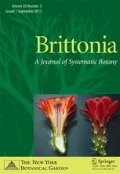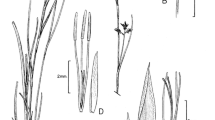Abstract
Recent molecular phylogenies have demonstrated that Pleurostachys (Cyperaceae) should be recognized as a section within Rhynchospora. Here all accepted species of Pleurostachys are transferred to Rhynchospora sect. Pleurostachys, five new combinations are made, and one new name provided. Rhynchospora austrobahiensis and R. contraligularis are described as new species endemic to the Atlantic forest of southern Bahia, Brazil. They are distinct from all other species of sect. Pleurostachys by having spikelets that are never clustered and basal leaves over 1 cm wide. The summit of the inner band of the leaf sheath on R. austrobahiensis is concave to triangular while that of R. contraligularis is arched with a distinct, chartaceous contraligule. Both species are illustrated and compared to other species of Rhynchospora sect. Pleurostachys.
Resumo
Filogenias moleculares recentes demonstraram que Pleurostachys (Cyperaceae) deveria ser reconhecido como uma seção dentro de Rhynchospora. Aqui, todas as espécies aceitas de Pleurostachys são transferidas para Rhynchospora sec. Pleurostachys, cinco novas combinações são feitas e um nome novo é fornecido. Rhynchospora austrobahiensis e R. contraligularis são descritas como espécies novas endêmicas da mata atlântica do sul da Bahia, Brasil. Elas são distintas de todas as outras espécies de seção Pleurostachys por terem espiguetas que nunca são agrupadas e folhas basais com mais de 1 cm de largura. O cimo do lado interno da bainha da folha de R. austrobahiensis é côncavo a triangular, enquanto o da R. contraligularis é arqueado com um contraligula cartáceo e distinto. Ambas são ilustradas e comparadas com outras espécies de Rhynchospora sec. Pleurostachys.



Similar content being viewed by others
Literature cited
Alves, M. & W. W. Thomas. 2015. Pleurostachys (Cyperaceae): nomenclatural notes, geographical distribution and conservation status. Rodriguésia 66(2): 369–378. https://doi.org/10.1590/2175-7860201566207
Amorim, A. M., P. Fiaschi, J. Jardim, W. W. Thomas, B. Clifton & A. M. Carvalho. 2005. The vascular plants of a forest fragment in southern Bahia, Brazil. Sida 21(3): 1727–1757.
Bentham, G. & J. D. Hooker. 1883. Genera Plantarum, vol. 3(2). Reeve, Williams & Norgate, London.
Boeckeler, O. 1875. Die Cyperaceen des königlichen Herbariums zu Berlin. Linnaea 9: 1–152.
Bruhl, J. J. 1995. Sedge genera of the world: relationships and a new classification of the Cyperaceae. Australian Journal of Systematic Botany 8: 125–305.
Buddenhagen, C. E. 2016. A View of Rhynchosporeae (Cyperaceae) Diversification before and after the Application of Anchored Phylogenomics across the Angiosperms. Doctoral Thesis, Department of Biological Science, Florida State University. https://doi.org/10.13140/RG.2.2.21617.02403
Buddenhagen, C. E., W.W. Thomas & A.R. Mast. 2017. A first look at diversification of beaksedges (tribe Rhynchosporeae; Cyperaceae) in habitat, pollination, and photosynthetic features. In: Diversity and phylogeny of the monocotyledons, Contributions from Monocots V. Memoirs of the New York Botanical Garden 118: 113–126. https://doi.org/10.21135/893275341.002.
Clarke, C. B. 1908. New genera and species of Cyperaceae. Kew Bulletin, Additional Series 8: 1–196.
Eiten, L. 1976. Inflorescence units in the Cyperaceae. Annals of the Missouri Botanical Garden 63: 81–112.
Goetghebeur, P. 1986. Genera Cyperacearum. Een bijdrage tot de kennis van de morfologie, systematiek en fylogenese van de Cyperaceae—genera. Doctoral Thesis, Rijkuniversiteit Gent.
Goetghebeur, P. 1998. Cyperaceae. Pp. 141-189 in K. Kubitzki, H. Huber, P. Rudall, P. Stevens & T. Stützel, Vascular flowering plants. Vol. 4. Springer, Berlin.
Hickey, M. & C. King. 2000. The Cambridge illustrated glossary of botanical terms. Cambridge University Press, Cambridge, U.K.
IUCN. 2012. IUCN Red List categories and criteria. Version 3.1. Second edition. Gland, Switzerland and Cambridge, UK.
IUCN Standards and Petitions Committee. 2019. Guidelines for using the IUCN Red List categories and criteria. Version 14. Downloadable from: http://www.iucnredlist.org/documents/RedListGuidelines.pdf. Accessed December 2019
Koyama, T. 1961. Classification of the family Cyperaceae 1. Journal of the Faculty of Science, University of Tokyo, sect. 3, Botany 8: 37–148.
Kükenthal, G. 1952. Vorarbeiten zu einer Monographie der Rhynchosporoideae. Pleurostachys. Botanische Jahrbücher für Systematik, Pflansengeschichte und Pflanzengeographie 75: 451–497.
Leão, A. C. & J. B. S. Gouvêa. 1973. Fisionomia, estrutura e condições ecológicas da vegetação da região cacaueira baiana, Folha Mascote. Boletim Técnico 22. Centro de Pesquisas do Cacau, Comissão Executiva do Plano da Lavoura Cacaueira, Ilhéus.
Melo, A. A. O. 1985. Levantamento dos solos do município de Uruçuca. Boletim Técnico 129. Comissão Executiva do Plano da Lavoura Cacaueira, Ilhéus.
Myers, N., R. A. Mittermeier, C. G. Mittermeier, G. A. B. da Fonseca & J. Kent. 2000. Biodiversity hotspots for conservation priorities. Nature 403: 853–858. https://doi.org/10.1038/35002501.
Pfeiffer, H. 1925. Monographia Pleurostachydearum. I. Pars specialis descriptioque specierum. Botanisches Archhiv 9: 225–242.
Queiroz, K. de. 2007. Species concepts and species delimitation. Systematic Biology 56: 879–886.
Radford, A. E., W. C. Dickison, J. R. Massey & C. R. Bell. 1976. Vascular plant systematics. Harper and Row, New York.
Rocha Filho, C. A. 1976. Diagnostico socioeconômico da região cacaueira, Vol. 5. Recursos Hídricos. Comissão Executiva do Plano da Lavoura Cacaueira and Instituto Interamericano de Ciências Agricolas-OEA, Ilhéus.
Smith, L. B. 1934. Taxonomic notes on American phanerogams – I. Phytologia 1(2): 81–82.
Soros, C. & J. J. Bruhl. 2000. Multiple evolutionary origins of C4 photosynthesis in the Cyperaceae. Pp. 629–636 In: K. L. Wilson & D. A. Morrison, Monocots: Systematics and evolution. CSIRO, Melbourne.
Thiers, B. 2019 (continuously updated). Index Herbariorum: A global directory of public herbaria and associated staff. New York Botanical Garden's Virtual Herbarium. Available from: http://sweetgum.nybg.org/science/ih/ (last accessed October 2019).
Thomas, W. W. & M. Alves. 2008. Towards a revision of the genus Pleurostachys (Cyperaceae): Preliminary results. In: R. Naczi & B. Ford (eds.), Sedges: Uses, diversity, and systematics of the Cyperaceae. Monographs in Systematic Botany from the Missouri Botanical Garden 108: 269–278.
Thomas, W. W., A. C. Araújo & M. Alves. 2009a. A preliminary molecular phylogeny of the Rhynchosporeae (Cyperaceae). In: W. W. Thomas, D. A. Simpson, A. A. Reznicek & J. R. Starr (eds.), Cyperaceae – Special Issue. Botanical Review 75: 22–29. https://doi.org/10.1007/s12229-008-9023-7.
Thomas, W. W. & M. R. V. Barbosa. 2008. Natural vegetation types in the Brazilian Atlantic Coastal Forest north of the Rio Doce. In: W. Thomas (ed.), The Atlantic Coastal Forest of Northeastern Brazil. Memoirs of the New York Botanical Garden 100: 6–20.
Thomas, W. W., J. G. Jardim, P. Fiaschi, M. Mariano-Neto & A. M. Amorim. 2009b. Composição florística e estrutura do componente arbóreo de uma área transicional de floresta Atlântica no sul da Bahia, Brasil. Revista Brasileira de Botânica 32(1): 41–54.
Acknowledgements
Financial support for field work resulting in collection and study of these species was provided by the National Science Foundation (DEB 9972116 and DEB 1342797) and the Beneficia Foundation. Many thanks to Marccus V. Alves for previous collaboration and discussions about species of Rhynchospora sect. Pleurostachys. I thank the curators of the herbaria consulted, especially those of CEPEC, JPB, MBML, NY, RB and UFP. Thanks also to two reviewers of this manuscript. I especially thank Bobbi Angell for the beautiful illustration and Elizabeth Gjieli for the distribution map.
Author information
Authors and Affiliations
Corresponding author
Rights and permissions
About this article
Cite this article
Thomas, W.W. Two new species of Rhynchospora (Cyperaceae) from Bahia, Brazil, and new combinations in Rhynchospora section Pleurostachys. Brittonia 72, 273–281 (2020). https://doi.org/10.1007/s12228-020-09621-0
Published:
Issue Date:
DOI: https://doi.org/10.1007/s12228-020-09621-0




